Wingless Flight in the M2-F1
Sometimes, the most interesting aircraft are the experimental ones that barely made it off the ground. Sometimes the most intriguing stories come out of things I don’t understand.
I was thinking about hybrid airships and I was struggling to understand the concept of a lifting body. My attempt to understand how a wingless vehicle could possibly fly led me to the NASA research. Once I saw the sci-fi looking M2-F1 being towed by a Pontiac convertible, I was hooked.
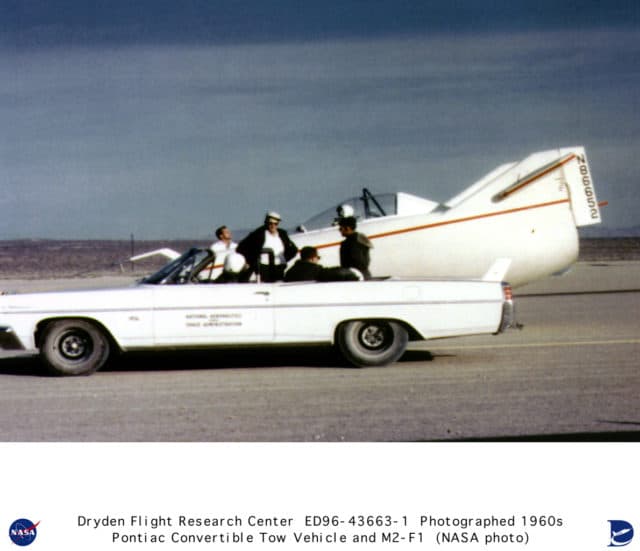
The concept of a lifting body has been discussed since the mid 1950s, with a series of possible shapes. My struggle to understand how the body could provide lift says more about my lack of physics understanding than anything else. However, I’m a bit relieved to see that in the 1960s, I was in good company: there were plenty of engineers at NASA who felt the same as I did.
NASA – The M2-F1: ‘Look Ma! No Wings!’
The idea of an aircraft without wings met with skepticism among engineers. R. Dale Reed of the NASA Flight Research Center – now the Dryden Flight Research Center – was the exception. Reed was excited about the concept and began testing a series of small balsa wood and tissue-paper lifting bodies, which he flew down the hallways of the center’s main office building and off its roof.
A lifting body is effectively a fuselage with little or no conventional wing. A fixed-wing aircraft is kept in the air by the forward motion of the wings. Helicopters have wing-shaped rotors (or rotor blades or rotary wings) which revolve around a mast. The flying wing maximises cruise efficiency at subsonic speeds by eliminating non-lifting surfaces. A dynastat, a type of hybrid airship, has both fixed wings and a lifting body and excels at long-endurance flights.
The key point is that a lifting body is inefficient at low airspeeds but the shape means that there’s very little drag, which has clear potential for subsonic, supersonic and hypersonic flight. NASA were particularly interested in its potential for spacecraft re-entry with a view to developing a lightweight manned spacecraft with a minimal amount of drag. Well, when I say NASA, initially, it was just Reed.
The engineer had more than a working knowledge of aviation: he was a general aviation pilot and he enjoyed building model aircraft. He became intrigued by the idea of the lifting body as a means to land a spacecraft horizontally after atmospheric re-entry.
Wingless Flight: The Lifting Body Story by R. Dale Reed
“Lifting” reentry is achieved by flying from space to a conventional horizontal landing, using a blunt half-cone body, a wingless body, or a vehicle with a delta platform (like the shape of the current Space Shuttle), taking advantage of any of these configurations ability to generate body lift and, thus, fly. We could not put conventional straight or even swept wings on these vehicles because they would burn off during reentry–although a delta platform with a large leading-edge radius might work. These vehicles, or lifting bodies as we called them, would have significant glide capability down-range (the direction of their orbital tracks and/or cross-range (the direction across their orbital tracks) due to the aerodynamic lift they could produce during reentry.
Putting his model aircraft experience to good use, Reed worked on the idea at home. He created a small model to illustrate the concept. His wife filmed the flights on their 8-mm home camera and Reed took the footage to work to present the concept.
It worked, sort of. NASA offered Reed $30,000 in funding, “about the cost of a Cessna,” to build a lightweight lifting-body prototype which would take less damage on atmospheric re-entry.
Reed recruited NASA craftsman Ernie Lowder for the project, who had worked on Howard Hughes’ Spruce Goose. Then he went to the local airfield to recruit Gus Briegleb, a glider manufacturer who was selling kits of a high-performance wooden sailplane that he had designed.
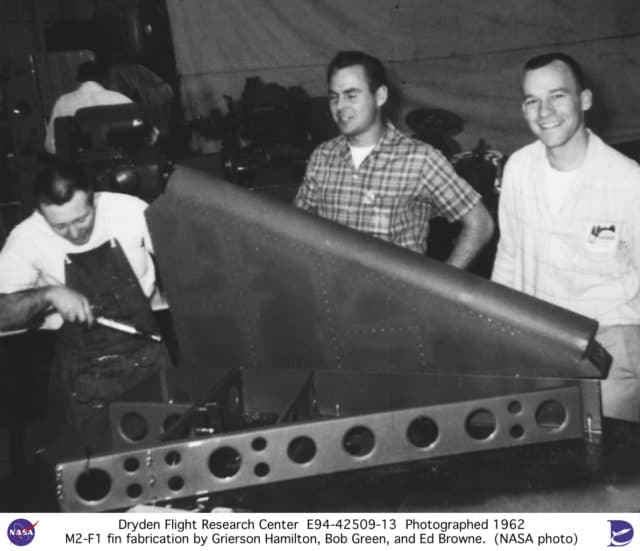
Wingless Flight: The Lifting Body Story
Once we had the initial team, we needed a place to work. We sectioned off a corner of the fabrication shop with a canvas curtain, labeling it the “Wright Bicycle Shop.” Indeed, we felt very much like the Wright Brothers in those days, working at the very edge between the known and unknown in fight innovation.
Together, they built the M2-F1, basically a mahogany plywood shell placed over a tubular steel frame. The tail, pushrod controls and the landing gear were taken from a Cessna 150. M stood for manned and F for flight version, so in this case, the first flight version of the lifting body prototype. The NASA website describes it as looking like a bathtub sitting on a tricycle.
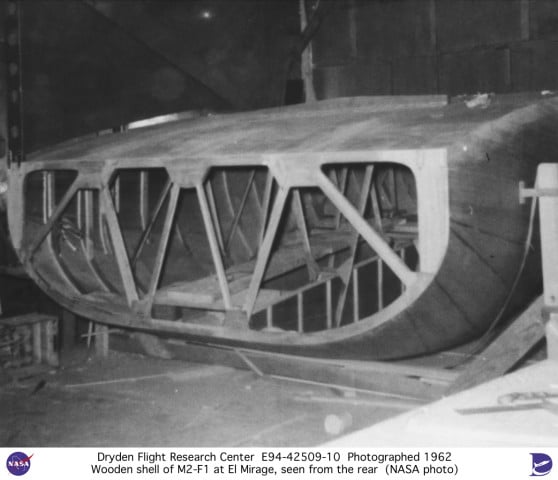
That’s where the Pontiac comes in. The prototype was unpowered so they needed a tow vehicle. A hot-rod enthusiast who worked at the Flight Research Center purchased a 1963 Pontiac Bonneville convertible for the job. But the Pontiac still wasn’t powerful enough to lift the M2-F1 off the ground so he took it to “Bill Straup’s renowned hot-rod shop near Long Beach” where the car was “hot-rodded” with racing slicks and a special gear box until it was able to reach 110 miles per hour (180 km/h) while towing the M2-F1. They also added radios and a rollbar and turned the front passenger bucket seat around so that a passenger could watch the M2-F1 being towed behind. The souped-up engine got about four miles to the gallon.
Wingless Flight: The Lifting Body Story
Of course, the Pontiac had to have government plates and the NASA logo on both sides. And just so no one would be encouraged to think the car was someone’s personal toy paid for with government funds, the hood and the trunk of the Pontiac were spray-painted high-visibility yellow, so that the convertible looked just like any other flight-line vehicle.
Whatever else they might have done, I don’t believe for a moment that the Pontiac ever looked like any other flight-line vehicle.
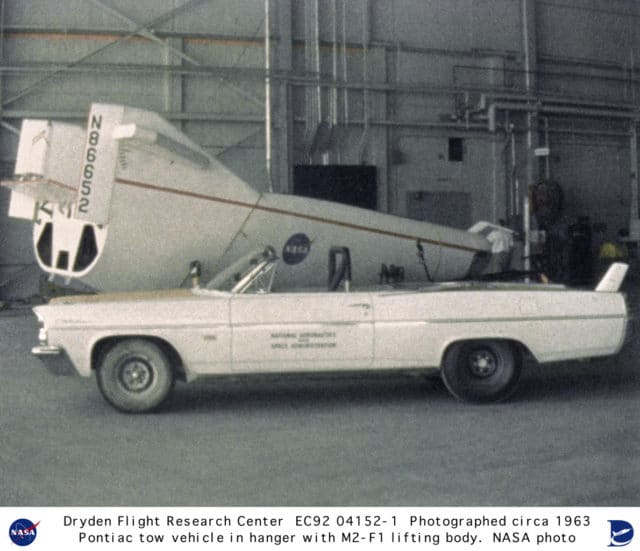
The problem now was that the prototype was designed as a full-scale model. The team had not been authorised to flight test the M2-F1.
The test pilot, Milt Thompson, argued that it wouldn’t really count as flying if they just lifted it off the lake-bed a couple of inches. And so, on the 1st of March 1963, they took the prototype out for a spin. Milt Thompson sat in the back as the Pontiac dragged it along Rogers Dry Lake. They initially drove at slower speeds, working their way up to the nose lift-off speeds over the course of the month. Eventually, they reached 86 miles per hour and Thompson carefully lifted the nose off the ground for the first time!
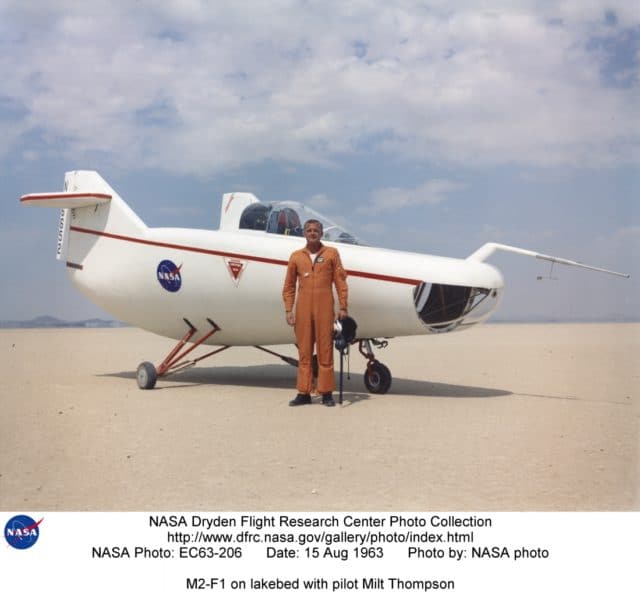
Wingless Flight: The Lifting Body Story
Slowly Milt brought the nose of the lifting body up until the M2-F1 got light on its wheels. Then something totally unexpected happened. The M2-F1 began bouncing back and forth from right to left. Milt stopped the bounce by lowering the nose, putting weight back on the wheels. Several times he again brought the nose up until the M2-F1 was light on its wheels, and each time the vehicle reacted the same way, Milt ending the bounce by lowering the nose as he had the first time.
He called a halt to the test and the team reviewed the movies taken of the attempt in an attempt to understand what made the M2-F1 bounce on the main landing gear, as there was no physical reason why the lifting body should oscillate. In the filmed footage, it became clear that the rudders were making small movements to the left and right which caused the vehicle to become unstable. But it wasn’t the test pilot; the slop and inertial weights in the rudder system were causing the rudders to move.
The next attempt was more successful: Thompson managed to lift off and remain airborne for a short time, still connected to the Pontiac.
The prototype was taken to Ames Research Center for Wind Tunnel Testing and to stabilise the control system. These tests were equally unorthodox.
Reed described it in his book…
The inside of the wind tunnel was an awesome sight, especially at night. One night, as the M2-F1 team was preparing for a test, I took my family on a tour of the tunnel. We boarded an open-cage elevator on the ground floor, then rose through a darkness of steel beams and unlit open spaces to the floor of the dimly lit test section. The tunnel was a huge closed-circuit system in the shape of a race track, it’s entire length being about half a mile. Soot from engines stained the walls, making the interior of the tunnel dark and dingy, adding an eeriness to the atmosphere. My wife, Donna, said that the tunnel would be a wonderful place to make an Alfred Hitchcock movie.
The M2-F1 didn’t have some of the more exciting features of research vehicles, like remote controls. So they convinced the wind-tunnel crew to let one person sit in the cockpit during the tests so that they could see the effects of the control settings. Otherwise, they would need to stop the test every time they wanted to change a pilot control; this way the wind tunnel could keep running.
Reed now admits that the tests were probably unsafe and would not be allowed at NASA these days. His descriptions of the tests are most evocative.
I found it scary sitting there over 20 feet off the ground inside a plywood barrel-like vehicle perched atop three spindly poles inside a dark cavern, shaking around as a windstorm screamed past at 135 miles per hour. I then decided that the best use of my time would be directing the tests in the safe confines of the wind tunnel control room. With the wind-tunnel operators and I peering at the wind-tunnel pilots through thick windows in the tunnel walls, they felt like some kind of biological laboratory specimens under scrutiny.
Thompson the test pilot, on the other hand, loved every minute of it. He asked them to attach a rope to the M2-F1 and let him lift off in the tunnel for a test flight but the wind-tunnel crew refused, worried that the tow line could break and “plaster the spacecraft and its pilot against the turning vanes.”
The vehicle underwent two weeks of wind tunnel testing. On the 16th of August 1963, the M2-F1 was authorised for flight. Thompson was now officially allowed to lift off of the lake bed. The team towed the M2-F1 at faster speeds reaching higher altitudes, until the final flight where Thomson managed to stay aloft for four miles. It was time to try to fly.
The Pontiac wouldn’t do for free flight, of course. Instead the plan was to use NASA’s R4D Skytrain, a Douglas C-47 (military transport plane based on the DC-3) utility aircraft which was mostly used for transport and to shuttle people to and fro.
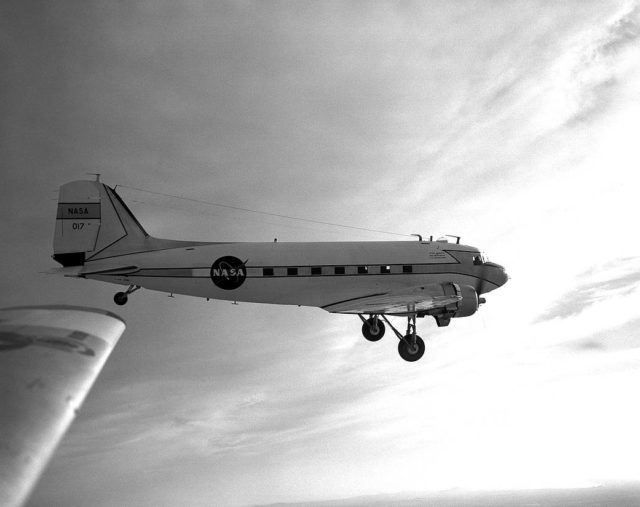
The R4D Skytrain was one of the work horses for NACA and NASA at Edwards AFB spanning a time from 1952 to 1984. Designated R4D by the Navy the aircraft was called C-47 by the Army, DC-3 by Douglas Aircraft and “Gooney Bird” by all others.
There was a problem: the World War II plane didn’t have a glider tow hook. They eventually found one is a surplus yard in Los Angeles and attached it.
Now that the flight of the prototype was becoming a reality, the team needed to overcome a series of objections. They had to install an ejection seat, which added 250 pounds to the M2-F1 although the fact that the seat and pilot were in the center, the added weight didn’t unbalance the lifting body. However, it did mean they needed higher airspeeds to fly. They added small rockets in the tail, which could be used to extend the landing flare for a few seconds if needed. And finally, they added a placard to the interior which stated No Aerobatic Roll Maneuvers.

Clearly there was some opposition, however the team’s program manager was 100% behind them, to the extent that Reed later wrote that he risked his career to support their project.
The plan was for the R4D Skytrain to tow the lifting-body to 5,200 feet over the lakebed and then let go. Thompson was given clear instructions that if he couldn’t achieve level flight he should simply eject and not try to recover the prototype.
Once in the air, Thompson found that the visibility from the M2-F1 cockpit was very bad. The Skytrain realigned to tow the smaller vehicle about 20 feet above it, so that the pilot could see the aircraft through his nose window.
Thompson released the tow line.
The M2-F1 immediately went into a steep descent of about 3,600 feet per minute. From the ground, it looked like the prototype was simply falling from the sky but this was exactly how it was supposed to work.
Unlike the normal landing of an airplane, landing the M2-F1 was more like pulling out of a dive. A pushover maneuver had to be done at about 1,000 feet to build airspeed up to about 150 miles per hour, followed by a flare at about 200 feet altitude from a 20-degree dive. The flare maneuver would take about 10 seconds, leaving three to five seconds for the pilot to adjust to make the final touchdown. Milt had the option of hitting a switch to fire a rocket motor, giving him five to six more seconds to adjust the sink rate before touchdown.
At 1,000 feet above the ground,Thompson lowered the nose into a 20° dive to increase the speed to 150 miles per hour. He flared at 200 feet and landed exactly on the planned touchdown spot without using the rocket.
It was perfect.
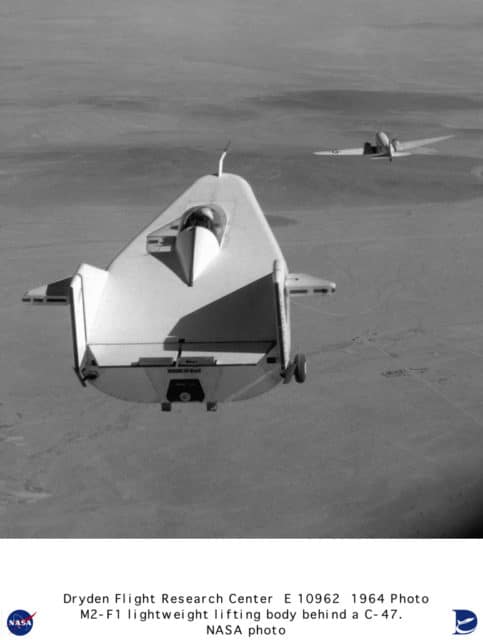
The flying research continued over 1964 and 1965, with the M2-F1 flying twice a week on average, or as quickly as the research team could “digest the data” from one flight and plan the tests for the next one.
The tests generally went well but then one day, it went wrong. Shortly after lift-off, at just 200 feet above the ground, the test pilot (Gentry) made small roll inputs to counteract the movements of the tow plane. But as they continued, he needed to make larger and larger corrections. The team on the ground watched in horror as the M2-F1 rocked side to side in an uncontrollable oscillation.
Travelling at 100 knots airspeed (about 115 mph or 185 km/h) the M2-F1 twisted upside down with the nose high. The test pilot released the tow line.
Normally, the vehicle would be straight and level and stabilised at 120 knots and the pilot would flare at about 300 feet above the ground. There was no strategy for dealing with the vehicle if it became inverted and the probability of recovery was effectively zero. But the test pilot ignored the odds. He continued to descend and then touched down on the lakebed as he completed the barrel roll. There was no time to think: the manoeuvre from releasing the line to landing took nine seconds. The landing gear broke as he touched down but nothing else was damaged, except, as Reed says, the test pilot’s pride.
The M2-F1 continued testing but three years after its first free flight, the M2-F1 rolled again. It was the same test pilot flying and this time he at least knew what to do. He released the tow rope and completed the barrel roll. This time he used the landing rocked to touch down perfectly and there was no damage to the M2-F1. Nevertheless, the management lost faith in the M2-F1 and the first lifting body was retired from flight in 1966.
The next model, the M2-F2, was based on the same design but bigger and heavier. Instead of being towed, the M2-F2 was launched from its mothership, NASA’s Boeing B-52 Stratofortress. It received mainstream attention after a crash in 1967, and the footage of the crash inspired the premise for a popular American television show, The Six Million Dollar Man.
When NASA astronaut Steve Austin is severely injured in the crash of an experimental lifting body aircraft, he is “rebuilt” in an operation that costs six million dollars.
Here are the opening credits:
And here’s footage of the real crash, in which the test pilot lost control on landing. Unfortunately, the only online version I found showing the various angles has been “improved” with music, so I recommend muting the audio before watching.
Note: if you subscribe to the mailing list and cannot see the videos, you may need to click through to the website to view them.
This was the only serious accident which occurred over the years of the lifting-body flight testing.
Research continued on manned lifting bodies, with a focus on metal heavyweight designs. The M2-F2 led the way to the Northrop HL-10 and the US Air Force X-24 programs, leading the way to the space shuttle programme .
The M2-F1 program proved to be the key unlocking the door to further lifting-body programs, including the current Shuttle spacecraft and several other vehicles currently in progress, such as the X-33. Flight tests of the M2-F1 supplied the boost in technical and political confidence needed to develop low lift-to-drag ratio, unpowered, horizontal-landing spacecraft.
The original M2-F1 was restored in the mid 1990s and returned to NASA Dryden. It is now on display at the Air Force Flight Test Museum at Edwards Air Force Base in California.
If you have found this of interest and would like to learn more, then I recommend downloading the book, which NASA have kindly made available as a PDF: Wingless Flight: The Lifting Body Story by R. Dale Reed








Thank you! I was an absolute lifting-body nut when I was a kid (not that I’ve changed…) It was very Buck Rogers and sci-fi.
“Wingless Flight” is an excellent book, and I’m glad to see it get some love.
Note that the X-38 Int’l Space Station emergency recovery vehicle is the exact same shape as the HL-10. Unfortunately, they decided it was cheaper to buy Russian Soyuz.
> this was exactly how it was supposed to work
And that’s why it’s so difficult to land a Shuttle, aside from the fact it’s unpowered and there’s no “do over” go-around ability.
I knew of the TV show (well enough to laugh at a parody of it) but never saw it. I remember hearing that it had some real-world footage, which these clips seem to verify; interesting to have confirmed. I’m not surprised that it ran into trouble; IIRC the flying wing never did very well either. Apparently giving up control leverage on one axis costs too much margin too much of the time, although the test pilot who inadvertently started two barrel rolls managed to work his way out of them — that sounds like serious pilot skills.
I hadn’t heard that the lifting body, unlike the Space Shuttle, had rockets to give it a bit more margin in landing, but it seems that simulator training (and possibly better instruments and/or computers) was enough, since the Shuttle never landed short or damagingly long in its career; now it’s retired, and we’ll see whether we ever again get multiple-use spacecraft.
Essentially a race car (and race boats) are inverted lifting bodies.
The aim is precisely to create a negative lift, so the vehicle does not take off.
This is an interesting article behind aerodynamic evolution in race cars https://www.f1network.net/main/s107/st22394.htm
Fascinating. This is not really my area of “limited expertise”. Sylvia has told, or summarized, the story exceptionally well.
Brave test pilots! I must admit that would not have had the guts to try these things out. The closest I came – but that was in an aircraft with wings – was during our training on the Corvette business jet.
There was no simulator ever built for this aircraft, all had to be done in the air. On one occasion the trainees had to do an engine out landing: both engines were reduced to idle and we were expected to bring the aircraft to a safe landing from a position within gliding distance of the airport. Like a glider, only with a much higher rate of descent.
But, as said, we had wings, flaps, speed brakes, nothing like the “lifting body” and beside, we could open the taps if we were misjudging the approach, with a very experienced test pilot as our instructor.
I had my moment of fun when approaching Londoin Heathrow on a clear, windless night ATC cleared us to land on any runway we chose. We were still at FL 100 (10.000 feet). I brouight the power back to idle and we put into practice what Capt. Briot had taught us.
But that was absolutely nothing compared to what these test pilots did in that wingless lifing body.
Were the elevators on the M2-F1 separately adjustable for some roll control?
Just came across this. I was an eye witness to the crash. I was a co-op student on my first work period. During this flight I took the ol’ Dodge pick up truck onto the lake bed to pop a can of purple smoke, sort of a more visible wind sock. After the crash, I helped with the investigation. From the cockpit camera over Bruce’s left shoulder we could see that he did recover well enough to land and just before landing he had his left hand on the blow-down gear handle but hesitated; the M2 pilots liked to blow the gear just before touchdown because it caused a bit of pitch down. He did pull it just after the aircraft hit the lake bed and the gear started down. We figured it would have gone down and locked it if had another 0.1 seconds, which would have been a “skip off the lake bed” landing, but it did not lock so collapsed. Bruce eventually came back with an eye patch and flew again, but never solo. NASA had a two-seat F-107 with a part of periscope eyes to test out if a shuttle could land on a spot without windows, so Bruce flew it a few times to see if it could be done with just one eye; I do not know the results.
Bruce would enter an office and tell the sec’y “I’ve had my eye on you” and when he left “I’ll keep an eye out for you.” This was just the culture at the FRC, especially amongst pilots who all knew their work could kill them.
Oh wow, what an experience. Thank you for taking the time to comment and clarify some of the issues. Scary times but also so very groundbreaking.
Further: Bruce got disoriented from extreme roll rates and when he recovered was in a big yaw condition and thought the helicopter was in his path, so he changed direction which took him over the lake bed where there were no “runway” lines, thus very little altitude clues. If you can get the sound track you will hear him say to get the helicopter out of the way; it was not in the way.
The aircraft was taken down to Hawthorne and rebuilt, this time adding a third, center vertical stabilizer, being called the M2-F3. I flew the Northrop shuttle to Hawthorne every morning, back every night, and did the drawings for changing the pylon adapter so that the M2 and the HL-10 would have a common B-52 pylon adapter.
The elevons (split elevators, so could go together for pitch, differentially for roll) were made of honeycomb and were damaged. I swiped a chunk of one of them, had the sheet metal shop cut it into 8″ x 12″ pieces, the staff artist made a template of the side view, then the machine shop sand blasted it onto the surface and I had Bruce and Jerry Gentry and Milt Thompson sign them, then gave them to my boss, etc. I still have this souvenir.
I knew Milt Thompson quite well. He and I hit it off from when I first encountered him in 1985 and for the next several years, until I moved on from writing about NASA for a living (I’m an author and publisher). I think he picked up on my natural enthusiasm for the things I was writing about, and I stood out a bit by dint of being an Englishman living and working in England but spending a lot of time in the States. And perhaps he was pleasantly surprised at how many pages I could devote to NASA’s aeronautical activities, past and present, but I had the luxury then of publishing my own magazine, Spaceflight News, so I could use as many pages as I wished!
Milt was a serene individual. He’d seen it all and had nothing to prove. He helped me a lot, and I’ve kicked myself in later life that I didn’t ask him to let me help him put an autobiography together. Instead, we did lots of in-depth articles based on interviews did with him.
Everyone knows about the lifting bodies and the X-15, which were central to Milt’s flying career, but less know about NASA’s Parasev Rogallo project and the attempts to launch a rocket to an altitude of one million feet from an F-104. Those projects saw Milt flying at opposite extremities of the speed and altitude spectrum, but received the same highly-professional treatment.
One time at Edwards, Milt introduced me to Marty Knutsen, who occupied the office adjoining his. Marty had been a CIA U2 pilot on the audacious overflights of Soviet territory. Former X-15 pilot Bill Dana was working at Edwards, still flying, at the same time as Milt and Marty Knutsen had their desk jobs, and Rogers Smith was there too, flying the X-29 at that time (he went on to pilot the last-ever flight of an SR-71). So being there then you were aware of the history and a sense of continuity from the early days of testing at Edwards.
I did interview Bruce Peterson about his lifting body crash. Another story for another time. It was in January 1986, nearly twenty years after the accident and a few days before the Shuttle Challenger disaster. Bruce was working secretly on the B-2 in those days and so when I in all innocence asked him what he was doing for a living these days, he was completely silent. I asked him once more. Silence again. Standard procedure, I guess, on the basis that – whatever is said – it gives something away!
This is fascinating! What a wonderful opportunity you created for yourself. I bet there are lots of great stories.
Thanks, Sylvia.
Yes, I was lucky in being in the right place at the right time, but I’d earned my place too. It’s usually a combination of skill and luck, isn’t it, in life.
I discovered three years ago that I’m dyslexic, so becoming an author was not the natural choice for a career! But I didn’t know I had it, so I pressed on in oblivious ignorance, assuming I was just ‘unusual’, or maybe plain stupid. Hoped people would pick up on the first part and not stop to think the second!
So I made a start, blagging my way initially as a teenager, getting little bits and pieces published. I mean really little news pieces. And then somehow got somewhere with it and made a success of it.
Aware that this is an aviation-safety website first and foremost, it’s maybe not the place for my anecdotal ramblings, but getting back to the safety theme with Bruce Peterson’s accident, I’m pretty sure (from memory) that a PIO was involved. The lifting body he was flying that day had an inherent roll-stability problem (which was ultimately cured when they added the third, central, tail-fin when the aircraft was rebuilt). But the roll problem kicked in and Bruce got into a PIO and the whole thing very rapidly got worse and worse. He was knocked unconscious when his head struck the cockpit canopy with the worsening condition.
I don’t have my published account of the crash handy, but if I find it I’ll post more at some point. I quoted most of what Bruce told me verbatim in that article, published in Spaceflight News in 1986.
Of his return to NASA, Bruce told me sardonically: “Of course, there was a ready market for one-eyed test pilots.”
The lifting bodies, of course, paved the way for the Space Shuttle, and interestingly, PIO was an early problem with the Shuttle Orbiter when they started launching it off its Boeing 747 mother-ship, in the time prior to the first spaceflight. Coming in to land and very close to the ground on one particularly noteworthy occasion – noteworthy because the Prince of Wales was watching and the problem could so nearly have caused a crash and the loss of the Orbiter and its crew – a horrendous PIO set in and it looked really disastrous for a few seconds. They knew what the problem was and they got it sorted out though.
Just to be clear: Bruce may have been unconscious for a few seconds, but he landed fully awake. As a co-op student I helped investigate the accident. There was a camera behind him and to the left. In the film we could see that he was over Rogers Dry Lake where there were no visual queues (see my first post) and literally had his hand on the lever to blow the gear down (high pressure air). It was common for pilots of these aircraft to put the gear down just before touchdown. In the room we were all saying “Pull it Bruce” and of course he did but it was just after he had made contact and sort of skipped up. If the gear had got down and locked then he would have rolled out, but we figured he was about .1 second too late. I don’t recall anything about being unconscious in flight, but his roll rate back and forth was nearly 300 degrees a second, so definitely disorienting,.
This is definitely a good place for anecdotal ramblings!
Maybe you and Sylvia could even select some older (or newer?) pieces of yours for a future blog post?
Between the M2-F1 and the M2-F2 (metal, powered, etc.) someone made a fiberglass shell around the F1. About a half in thick as I recall. I was in Operations, reporting to Perry Row (Rowe?). Perry wanted a procedural trainer for pilots. So I took the fiberglass shell and the blueprints of the F2 interior and took them to the sheet metal shop. They built an interior exactly like the F2 interior in that fiberglass shell made from the F1. I had the back part, aft of the pilot seat, cut off and a rack built there for mounting the computer to run the flight simulation,. Of course it was analog, so a rat maze of wires on a board with the “computer” guts underneath. The pilots would fly the planned flight profile but the Ops guy would sometimes simulate a flame out, cockpit fire, control system failure, etc., and the pilot would practice what to do in those circumstances. You need to understand that among the Ops staff and pilots there was always running jokes. Maybe pressure relief, but a lot of fun. We played hearts at lunch with up to four decks of cards, score kept on a white board. If someone would ask “Have hearts been broken?” the usual response was “This isn’t a game for Helen Keller.” In that light, when I built the trainer I put a “Pilot feedback system” in it for the Ops guy to use if the pilot did the wrong thing. It was a spring loaded metal bar that the Ops guy could release and it would goose the pilot.
I have a photo of the procedural trainer you mention, Mike. In the photo, Bill Dana is seated at the controls, with Jack Kolf – Project Manager on the M2-F2 and M2-F3 programmes – standing at his side, leaning over towards the cockpit.
In the background is a mass of computer equipment, including a graph-printer. All 1960s-era items, so all very large by today’s standards!
Great to have your first-hand account on that.
Regarding my earlier posts, above – they were written ‘on the hoof’ without reference to my notes from the period. So, the keep the record straight, PIO did not play any part in Bruce Peterson’s accident. I said that it did in my post, but I was confusing Bruce’s ill-fated flight with at least one earlier incident with the M2-F2 in which PIO was certainly a major issue (the pilot on that occasion was Milt Thompson: I know so because he told me about it in person and I made a recording of our discussion on audio tape and now have a transcription to hand).
I was wrong, too, to say that Bruce was knocked unconscious when he encountered the instability problems that led to his crash. He was conscious throughout the flight itself, but was quite badly dazed when his helmeted head was hammered from side to side against the cockpit canopy. “It was like a series of shots from a fist,” was how he described it to me.
Anyway, Sylvia has recently published my latest and most comprehensive account of Bruce’s accident elsewhere on Fear of Landing and will no doubt provide a link here for those who haven’t seen it yet.
All of us, either witnesses or interviewers, seem to have the same set of details, so a rather well documented tragedy. Another aspect I have not see reported is during the whole lifting body research at large the students at the Test Pilot School, also at Edwards, were working on the high speed, high angle drop and flare in F-104s. They would get to altitude, then chop power to idle, put out full flaps and speed brakes to create as much drag as possible. This would simulate a lifting body approach. So as has been mentioned, the tricky part was the flare and a jet engine at idle takes what seems like forever to spool up and give any thrust, so this had to be done “just right.” I don’t know how many, but I know that at least one test pilot school student flared to low and died by crashing right into the landing spot. We saw the black spot resulting from that. Could have been more, or maybe the one accident stopped that activity. Rumor had it that a student destined to be the first black astronaut died just that way, but I have not been able to document it one way or another.
Great minds think alike, Mendel !
I suggested this very idea to Sylvia in an e-mail yesterday so we’ll see what happens …
It’s Sylvia’s website and I don’t ever want to be a gatecrasher – even if my visits are short and sweet !
For various reasons I won’t trouble you with, my time is very limited, but it would be nice to dig out some of my older stories and so forth and refresh them for a new audience. And maybe even write some new pieces occasionally, to exercise my writing muscles, as my career has been taking me down a somewhat different path for some time now and I do rather miss writing the kind of stuff I used to write before.
Anyway, as said, let’s see. It’s a great website, as I have told Sylvia, and I’m pleased I spotted it – which happened purely by chance the other day, as I was researching something else at the time and just strayed into it.